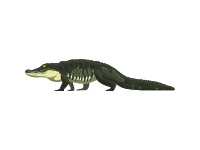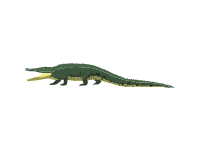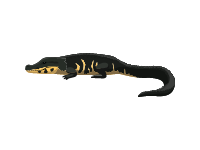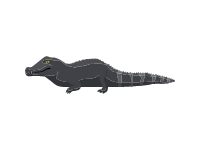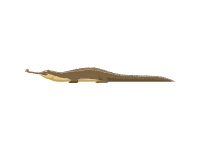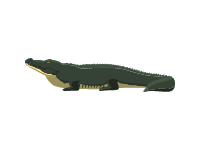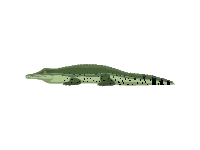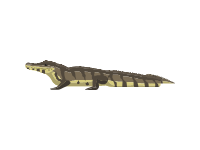The black caiman (Melanosuchus niger) is a species of large crocodilian and, along with the American alligator, is one of the biggest extant members of the family Alligatoridae and order Crocodilia. It is a carnivorous reptile that lives along slow-moving rivers, lakes, seasonally flooded savannas of the Amazon basin, and in other freshwater habitats of South America. It is a large species, growing to at least 5 m (16 ft) and possibly up to 6 m (20 ft) in length, which makes it the fourth-largest reptile in the Neotropical realm, behind the American alligator, American crocodile, and the critically endangered Orinoco crocodile. The black caiman is one of the largest extant reptiles. It is the largest predator in the Amazon basin and possibly the largest member of the family Alligatoridae. It is also significantly larger than other caiman species. Most adult black caimans are 2.2 to 4.3 m (7 ft 3 in to 14 ft 1 in) in length, with a few old males growing larger than 5 m (16 ft 5 in). Sub-adult male specimens of around 2.5–3.4 m (8 ft 2 in–11 ft 2 in) will weigh roughly 95–100 kg (209–220 lb), around the same size as a mature female, but will quickly increase in bulk and weight. The average size of adult females at their nests was found to be 2.8 m (9 ft 2 in). Mid-sized mature males of 3.5–4 m (11 ft 6 in–13 ft 1 in) weigh approximately 300 kg (660 lb), while larger specimens exceed 400 to 500 kg (880 to 1,100 lb), being relatively bulky crocodilians.A relatively small adult male of a total length of 3.4 m (11 ft 2 in) weighed 98 kg (216 lb) while an adult male considered fairly large at a length of 4.2 m (13 ft 9 in) weighed approximately 350 kg (770 lb). Another sampling of subadult males found them to range in length from 2.1 to 2.8 m (6 ft 11 in to 9 ft 2 in), averaging 2.45 m (8 ft 0 in), and that they weighed from 26 to 86 kg (57 to 190 lb), averaging 48 kg (106 lb). The black caiman broadly overlaps in size with the American alligator (Alligator mississippiensis), although it is on average larger at maturity. In some areas (such as the Araguaia River) this species is consistently reported at 4 to 5 m (13 ft 1 in–16 ft 5 in) in length, much larger than the alligator (which rarely even reaches 4 meters), although specimens this size are uncommon. Several widely reported but unconfirmed (and probably largely anecdotal) sources report that the black caiman can grow to over 6.1 m (20 ft 0 in) in length and weigh up to 1,100 kg (2,400 lb). While it is unclear what the source for this maximum size, many scientific papers accept that this species can attain extreme sizes as such.
